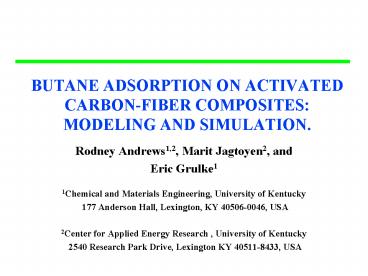BUTANE ADSORPTION ON ACTIVATED CARBONFIBER COMPOSITES: MODELING AND SIMULATION' - PowerPoint PPT Presentation
1 / 23
Title:
BUTANE ADSORPTION ON ACTIVATED CARBONFIBER COMPOSITES: MODELING AND SIMULATION'
Description:
1Chemical and Materials Engineering, University of Kentucky. 177 Anderson Hall, Lexington, KY 40506-0046, USA ... automotive paint booth process equipment ... – PowerPoint PPT presentation
Number of Views:112
Avg rating:3.0/5.0
Title: BUTANE ADSORPTION ON ACTIVATED CARBONFIBER COMPOSITES: MODELING AND SIMULATION'
1
BUTANE ADSORPTION ON ACTIVATED CARBON-FIBER
COMPOSITES MODELING AND SIMULATION.
- Rodney Andrews1,2, Marit Jagtoyen2, and
- Eric Grulke1
- 1Chemical and Materials Engineering, University
of Kentucky - 177 Anderson Hall, Lexington, KY 40506-0046, USA
- 2Center for Applied Energy Research , University
of Kentucky - 2540 Research Park Drive, Lexington KY
40511-8433, USA
2
Introduction
- Air Quality Issues
- Volatile organic compounds (VOCs) are precursors
to the formation of ozone and smog detrimental to
the environment and health - acute respiratory problems
- decrease lung capacity
- impair immune system
- Amendments to the clean air act of 1990
- reduction in emissions of 149 (VOCs)
3
Examples of Activated Carbons for VOC removal
- flexographic printing acetates and alcohols
- automotive paint booth process equipment
- bakeries ethanol
- styrene emissions 32 million lbs/year in 1990
4
VOC Removal Technologies
- Adsorption
- Thermal oxidation
- -VOC ? H2O and CO2
- -high energy consumption
- -dilute air streams
- Biofiltration
- -low concentrations
- -low operating costs
- Combined Processes
5
Advantages of ACF for VOC Adsorption
- Often very low concentrations of VOCs in large
air volumes - short contact times (lt0.01 sec)
- concentrations down to 10 ppm
- requires deep beds of granular activated
carbon (GAC) - high pressure drop
- Rate of adsorption can be greatly increased
- micron vs millimeter dimensions for fibers
- Fourier Mass Transfer Time for 90 Change
- 3 mm granule 0.032 sec
- 25 mm fiber 0.000005 sec
6
Activated Carbon Fibers
- As-produced Fibers
- low bulk density
- difficulties in handling and containment
- Composites
- novel monolithic form
- design flexibility - produced to any size or
shape - rigid, highly permeable, strong
- open internal architecture
7
Carbon Fiber Composite
8
Objectives
- Adsorption of butane on GAC and carbon
fiber composite beds at low butane
concentrations. - Apply Quasi-lognormal distribution (Q-LND)
approximation to predict breakthrough curves - Compare model with data
- -applicability and fit to data
- -calculation intensity and stability
- -implications
9
Experimental
- Equal volume beds of activated carbon fiber
composites and commercial GAC. - Butane 20 -100 ppm in dry nitrogen.
- Carbon Properties and Experimental Parameters
- Sample BET Mass of Density
Contact time DP - s.a.(m2/g)
carbon(g) (g/cc) (s-1) (psi) - GAC(F-400) 1014 46 0.48
0.082 1.01 - Composite 789 14 0.15
0.081 0.59 - Contact time (bed vol/flow vol/sec)
10
Schematic of Flow System
11
Pressure Drop Requirements
12
Efficiency of Butane Removal
- Rate of removal of butane at breakthrough
- per mass (g/hr/g)
- Concentration(ppm) Composite GAC
Ratio - 20 0.013 0.0039 3.33
- 50 0.034 0.0093 3.66
- 100 0.059 0.015 3.93
- Mass Transfer Coefficients from Sherwood
correlation - Composite kc 1.38 m/s
- GAC kc 0.85 m/s
13
Quasi-lognormal Distribution Approximation
- Developed by Xiu et al
- AIChE Journal, 43(4), 979, 1997.
- Modeling fixed-bed adsorbers with
- fixed-bed adsorbers
- axial dispersion
- external film diffusion
- intraparticle diffusion
- Adjustable for varying particle geometry
14
Q-LND Approximation
- column operates isothermally
- Ficks Law of Diffusion
- axial dispersion
- intra-particle transport
- linear adsorption isotherm
- axial fluid velocity is constant
15
Modeling Experimental Data
- Step feed input
- moments of the impulse response
- quasi-lognormal probability density function
- Dimensionless forms
- Peclet number
- Biot number
- distribution ratio
- single, concentration dependent, fitting parameter
16
Breakthrough Profile for Butane on GAC Bed
Data ? 100 ppm, 50 ppm, x 20 ppm. Model
Continuous curves.
17
Breakthrough Profile for Butane on Composite Bed
Data ? 100 ppm, 50 ppm, x 20 ppm. Model
Continuous curves.
18
Applicability and Fit to Data
- Fit data well over concentrations studied
- distribution ratio was single fitting parameter
- Calculated mass transfer coefficients
- 0.3 m/s
- 1.55 m/s
- good comparison with Sherwood number
- Assumptions in model appear valid
- Peclet and Biot numbers within range of those for
similar systems found in literature
19
Calculation Intensity and Stability
- Computationally simple
- solved in Mathcad desktop package
- Converges rapidly to solution
- Easily tuned for changes in system
- adsorbent particle shape
- adsorber bed parameters
- Solution convergence is stable
20
Implications for Scale-Up
- Applicability criterion
- HD is combined particle mass-transfer coefficient
- ? is bed-length parameter
- ? is distribution ratio
- p is particle shape factor
- May extend range of inequality
- fit to experimental data outside this range
21
Conclusions
- Q-LND Approximation predicts breakthrough
profiles for butane on GAC and ACFC - Model is applicable at low butane concentrations
- Computation
- rapid convergence
- simple (off the shelf solution)
- easily tunable
- Allows for rapid simulation of novel systems
22
Future Work
- Alternative bed configurations
- candle filters
- large diameter fibers
- Heat Transfer and Desorption
- electrical heating
- Alternative feed conditions
- multiple beds
- ramped feed
23
Acknowledgments
- This work was sponsored by CAER, University of
Kentucky. - The authors would like to acknowledge
- Danny Turner and Rodney Johnson for help with
- experimental work.
- Kathie Sauer for help with graphics.































